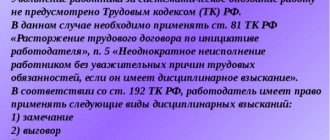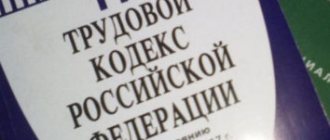10.08.2019
0
1223
5 minutes.
At any enterprise, specific situations may arise when employees violate legal requirements or internal regulations. In this case, an internal investigation is conducted to hold the employee accountable. To do this, a commission must be appointed that examines all kinds of evidence confirming the specialist’s guilt. It is she who makes the decision regarding the application of certain punishments. The possibility of challenging a disciplinary sanction by an employee depends on the correct execution of documents within this process.
Timing of internal investigation
The time frame for conducting an internal investigation according to the Labor Code (Article 193 of the Labor Code of the Russian Federation) should not exceed 1 month from the discovery of the event that served as its cause. Usually the deadline is specified in the order itself. It should be noted that there is a statute of limitations for holding an employee liable, which does not include:
- employee's sick time;
- the length of time the employee is on vacation;
- the time required to take into account the opinion of a trade union or other representative body of workers.
In total, it is possible to bring the culprit to disciplinary liability no later than six months (and in cases related to corruption - three years). After this period, it will no longer be possible to prosecute. Based on the results of an audit, inspection of financial and economic activities or an audit, this period is no more than two years from the date of commission or discovery of the offense. These periods do not include the period of criminal proceedings (if it has been opened).
Sample act of internal investigation at an enterprise
Sample request for explanations
Investigation procedure
The decision to implement the procedure is made by the director of the organization. There must be good reasons for this, confirmed by official documents. You need to understand how to competently conduct an internal investigation at an enterprise. To do this, perform the following steps:
- Detection of violation. The day the misconduct was discovered is the date when the head of the company is informed of a specific situation. The fact of such an action on the part of the hired specialist must be recorded, for which a memo is drawn up addressed to the director of the company.
- Deciding to conduct an investigation. For this purpose, the manager issues an appropriate order.
- Formation of the commission. It does not include the immediate superior of the offending employee. It is advisable to involve at least three specialists. The work of this collegial body is to study the offense, the extent of the damage caused, the reasons for the situation and discuss possible penalties. Additionally, preventive measures are being developed to prevent similar violations in the future. An explanatory note is taken from the culprit, and written testimony is also collected. Other documents are prepared, which include an inventory act, examination results, reports of inspectors or other papers.
- Presentation of results. The check ends after all the specifics of the offense have been clarified. For this purpose, a final act is drawn up, signed by all members of the commission. It provides the results of the investigation, describes the direct violation, the circumstances of the situation and the penalties applied to the culprit. All collected documents are attached to the act. They are registered in a special journal and signed by the director.
The head of the company and all members of the commission must have a good understanding of how an internal investigation is conducted in the organization. In this case, there will be no grounds for challenging the decision. The audit can be regulated not only by legal requirements, but also by the company’s internal regulatory documents.
What might be the reason for an investigation?
The job description of any employee contains a section that prescribes responsibility for certain violations. Typically there are clauses about:
- causing damage to the company,
- damage to inventory items,
- non-compliance with labor discipline,
- negligent performance of labor functions,
- disclosure of trade secrets, etc.
All these offenses can entail quite serious consequences for the organization and cause an internal investigation. And if this happens, then the internal “investigation” will help to establish the true cause of the incident and determine the degree of guilt of a particular employee.
First stage: Issuance of an order
The head of the organization, upon receiving information about the theft of goods from a warehouse, must issue an order to conduct an internal investigation, appoint an official or a group of responsible employees who will conduct the internal inspection, and indicate its deadlines.
The order is needed to give the inspection staff the appropriate rights. And here is copying documents, and various types of reconciliations, and checking accounting (financial) documents, and studying personal files, etc.
The order is announced and signed only by those interested, in this case - the officials where the theft occurred and the inspector himself.
Important: An internal internal investigation should be entrusted to an experienced employee who knows a lot about this matter.
A corresponding observation file is opened, indicating its affiliation, for example, “Documents on the fact of theft ...”. Documents in the folder should be stored in appropriate sections.
The inspection documents in the observation file with the documents in it and other inspection materials should be stored in a separate room in a safe, accessible only to the employee appointed for the inspection. It is no secret that a thief or a group of swindlers, if the verification documents are not stored properly, can “secretly” remove them from the folder, and also subsequently or immediately destroy the existing originals in order to cover up the traces of their crime with these actions.
In addition, every manager must remember that, as practice shows, managers in whom he completely trusts may also be involved in individual thefts, especially on a large scale.
Responsibility for disciplinary offenses
The decision to bring an employee to disciplinary liability is made at the discretion of the employer. It must be accepted by the head of the organization within three days from the end of the investigation. Some employers limit themselves to mild measures of influence: holding conversations, expressing reproach, etc. The Labor Code of the Russian Federation provides for three types of punishment: reprimand, reprimand and dismissal on appropriate grounds. Other penalties cannot be applied to the employee, with the exception of employees who are subject to special statutes and regulations on labor discipline (Part 5 of Article 189 of the Labor Code of the Russian Federation).
The heads of an organization or its structural unit or their deputies are subject to mandatory disciplinary action for violation of labor legislation and other acts containing labor law norms, the terms of a collective agreement, or agreement. If the fact of a violation was confirmed during the inspection, the official must be subject to disciplinary action up to and including dismissal (Article 195 of the Labor Code of the Russian Federation).
The decision on a disciplinary sanction is formalized by an order (see Sample 6), which identifies the guilty officials, the penalties imposed and the grounds for the decision.
For each disciplinary offense, only one disciplinary sanction can be applied. To record official investigations and their results, a Journal of Internal Investigations is maintained in paper or electronic form (see Sample 7). It is advisable to store all investigation materials filed in separate files or in one file and place them in chronological order.
In accordance with Art. 193 of the Labor Code of the Russian Federation, the employee must be familiarized with the order to apply a disciplinary sanction within three working days of the day of its publication, not counting the time of his absence from work. In case of refusal of the employee, a corresponding act is drawn up. Art. 248 of the Labor Code of the Russian Federation establishes that an order to recover from the financially responsible person the amount of damage caused is issued no later than one month from the moment the employer finally establishes its amount.
ATTENTION!
It is advisable that the employee familiarize himself with the entire package of documents before signature. This may prevent the employee from filing a claim in the future, since he knew in advance the employer's reasoned position.
If, during an internal investigation, signs of a crime were discovered (for example, an employee used official authority for personal gain), it is necessary to name them and make proposals to the head of the organization to consider initiating a criminal case.
T.V. Voitsekhovich
Who is involved in the review?
An internal investigation is carried out by a commission appointed by the head of the enterprise.
In large companies, this is entrusted to security or internal audit employees. If the enterprise does not have such personnel, any responsible team members can be assigned to study the situation. The main thing is that these employees are not personally interested in the outcome of the proceedings and can give an objective assessment of the collected facts. Therefore, it is impossible to invite close friends or relatives of the offending employee, as well as those who have personal hostility towards him, to the commission.
Another basic rule is that members of the commission should not be in any way connected with a disciplinary offense. The composition of the group is determined by the corresponding order, which all members become familiar with upon signature.
There is no point in forming a group of employees who are categorically against participating in the proceedings. Otherwise, the situation will not be analyzed with complete care. A secretary is assigned to the group, who will clearly monitor the correct preparation of all necessary documentation.
What does the commission find out?
During the inspection, the following circumstances are revealed:
- the essence of the violation;
- the amount of damage caused;
- the reasons and conditions that led to the offense;
- the person who committed the offense;
- degree of guilt;
- mitigating and aggravating circumstances;
- measures to bring perpetrators to justice;
- preventive measures to prevent such violations.
When the circle of potentially guilty persons has been determined, and in some cases it can be quite wide, the commission collects written explanations. In this case, explanations can be collected both from the perpetrators and from employees who, in one way or another, can explain what happened.
An explanatory note is drawn up by the employee on the basis of a notification issued by the commission. The notice describes the incident and may include a list of questions that the employee must answer. In the copy of the notice that remains on file with the commission, the employee must indicate the date of receipt of the notice and sign.
IMPORTANT!
The employee has the right to refuse to provide explanations. In this case, it is necessary to record this fact in the act of refusal to provide an explanation. It is composed by members of the commission.
An explanatory note is drawn up in any form by hand addressed to the manager, the date is indicated and a signature is placed. If the employee admits his guilt, he has the right to indicate the presence of mitigating circumstances in an explanatory note.
In addition to the explanatory note, the commission collects other documents that can shed light on the circumstances of the incident: reports and official notes of eyewitnesses of the incident, inventory reports, opinions of auditors and independent experts, reports of measurements of control and measuring equipment.








